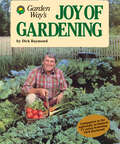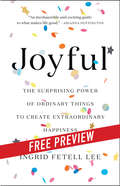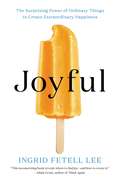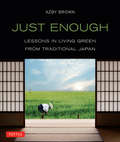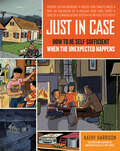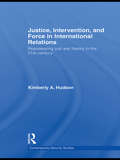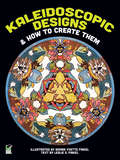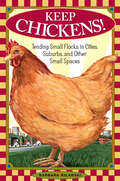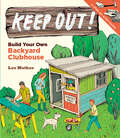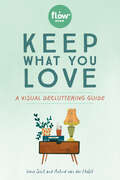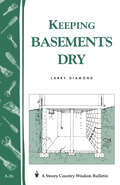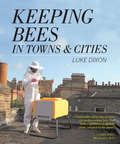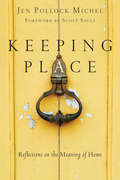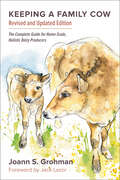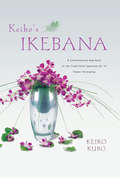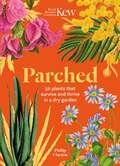- Table View
- List View
Joy of Gardening
by Dick RaymondFull of useful tips and practical garden wisdom, this straightforward guide shows you everything you need to know to grow a more bountiful harvest with less work. Stressing the utility of raised beds and wide rows, gardening expert Dick Raymond shares his time-tested techniques for preparing the soil, starting plants, and controlling weeds. With helpful photographs, clear charts, and profiles of reliable garden vegetables, Joy of Gardening will inspire you to grow your best crop ever.
Joyful: The Surprising Power of Ordinary Things to Create Extraordinary Happiness
by Ingrid Fetell LeeDesigner and TED star Ingrid Fetell Lee explains how to cultivate a happier, healthier life by making small changes to your surroundings. Have you ever wondered why we stop to watch the orange glow that arrives before sunset, or why we flock to see cherry blossoms bloom in spring? Is there a reason that people -- regardless of gender, age, culture, or ethnicity -- are mesmerized by baby animals, and can't help but smile when they see a burst of confetti or a cluster of colorful balloons. We are often made to feel that the physical world has little or no impact on our inner joy. Increasingly, experts urge us to find balance and calm by looking inward -- through mindfulness or meditation -- and muting the outside world. But what if the natural vibrancy of our surroundings is actually our most renewable and easily accessible source of joy? In Joyful, designer Ingrid Fetell Lee explores how the seemingly mundane spaces and objects we interact with every day have surprising and powerful effects on our mood. Drawing on insights from neuroscience and psychology, she explains why one setting makes us feel anxious or competitive, while another fosters acceptance and delight -- and, most importantly, she reveals how we can harness the power of our surroundings to live fuller, healthier, and truly joyful lives.
Joyful: The Surprising Power of Ordinary Things to Create Extraordinary Happiness
by Ingrid Fetell LeeDesigner and TED star Ingrid Fetell Lee explains how to cultivate a happier, healthier life by making small changes to your surroundings. Have you ever wondered why we stop to watch the orange glow that arrives before sunset, or why we flock to see cherry blossoms bloom in spring? Is there a reason that people -- regardless of gender, age, culture, or ethnicity -- are mesmerized by baby animals, and can't help but smile when they see a burst of confetti or a cluster of colorful balloons. We are often made to feel that the physical world has little or no impact on our inner joy. Increasingly, experts urge us to find balance and calm by looking inward -- through mindfulness or meditation -- and muting the outside world. But what if the natural vibrancy of our surroundings is actually our most renewable and easily accessible source of joy? In Joyful, designer Ingrid Fetell Lee explores how the seemingly mundane spaces and objects we interact with every day have surprising and powerful effects on our mood. Drawing on insights from neuroscience and psychology, she explains why one setting makes us feel anxious or competitive, while another fosters acceptance and delight -- and, most importantly, she reveals how we can harness the power of our surroundings to live fuller, healthier, and truly joyful lives.
Juan O'Gorman: A Confluence of Civilizations
by Catherine Nixon CookeTo create the "Confluence of Civilizations" mural commissioned for the 1968 World's Fair in San Antonio, Texas, Juan O'Gorman collected natural stones from all over Mexico-twelve colors in all-field stones that the artist knew would never fade or change their hue. Juan O'Gorman: A Confluence of Civilizations follows the life of Juan O'Gorman and covers the creation of this spectacular piece of midcentury public art that stands the test of time not just in vibrancy but as one of the most influential works created by a storied Mexican artist.Juan O'Gorman was a not only a painter and a muralist, a mosaic artist, a critic, and a professor, but he was also an architect and a revolutionary; possibly most famous for his close friendship with Diego Rivera and Frida Kahlo and as designer of their infamous two-house studio in Mexico City-Casa Azul-linked by a symbolic bridge.To celebrate San Antonio's "HemisFair" Exposition in 1968, Juan created the giant mosaic mural that still adorns one wall of the Lila Cockrell Theater along San Antonio's famed River Walk. The design plans for the five ton mosaic measured 2600 square feet and consisted of 540 numbered panels, each weighting about 90 pounds.
Just Clean Enough: Home Organization in an Imperfect World
by I. B. Caruso Jenny SchroedelA clean house means peace of mind. But who has the time to keep on top of it? Fortunately, this book breaks down home organization and gives busy families a solution. Unlike other decluttering books that press for perfection, this flexible guide features tips for each room in the house and helps you tackle your clutter in any way that works for you. With helpful icons that highlight quick tasks more suitable for weeknights as well as time-consuming jobs best left for the weekend, you will clean up and still have time for fun! After all, why spend all day cleaning when it's easy to do small things, like: dump out the junk drawer, toss unnecessary papers, corral kids' toys, clean out the medicine cabinet. Before long, you will be able to clean up your act--one closet, one room, one day at a time!
Just Enough
by Azby BrownThe world has changed immeasurably over the last thirty years, with more, bigger, better being the common mantra. But in the midst of this constantly evolving world, there is a growing community of people who are looking at our history, searching for answers to issues that are faced everywhere, such as energy, water, materials, food and population crisis.In Just Enough, author Azby Brown turned to the history of Japan, where he finds a number of lessons on living in a sustainable society that translate beyond place and time. This book of stories depicts vanished ways of life from the point of view of a contemporary observer, and presents a compelling argument around how to forge a society that is conservation-minded, waste-free, well-housed, well-fed and economically robust.Included at the end of each section are lessons in which Brown elaborates on what Edo Period life has to offer us in the global battle to reverse environmental degradation. Covering topics on everything from transportation, interconnected systems, and waste reduction to the need for spiritual centers in the home, there is something here for everyone looking to make changes in their life.Just Enough is much-needed beacon in our evolving world, giving us hope in our efforts to achieve sustainability now.
Just Green It!
by Ron Beres Lisa BeresGoing Green has never been so easy!The array of so-called "green" products on the market is dizzying and often misleading. Consumers need one reference book that clearly lays out what is the better choice--between brands, benefits, and costs. Just Green It! compares brand-name products, making it easy for consumers to make environmentally friendly choices on everything from light bulbs to mattresses to baby food. It tells you which products are the best for the planet and also healthy for you, your kids, your home, and your budget. For the average consumer, this means clarity of green definitions and product comparisons that are no longer a luxury, but a necessity.Authors Ron and Lisa Beres debunk the "greenwashing" that is so prevalent in modern marketing and teach readers how to know the difference between such confusing terms as "natural," "organic," "chemical free," and "nontoxic."Full of surprising facts and lots of ways to save money and help the environment, this is an essential book for the modern age. Did you know that ...The Great Wall of China and the Staten Island Landfill--Fresh Kills--are the only two manmade structures on Earth that are large enough to be seen from outer space.It is a higher carbon footprint to drink imported vodka?The phosphoric acid in soda leaches calcium from our bones and can lead to osteoporosis?The Green Movement is concerned about the effects of our collective carbon footprint on the planet. A "green home" is one that does not endanger the planet's health. The Beres, on the other hand, are concerned with how our footprint is endangering the health and well being of each individual.A guidebook for navigating the oversaturated Green marketplace, Just Green It! is a must have for today's tough economy. Just GREEN It! was chosen in May 2011 as an honorable mention by San Francisco's 2011 Green Book Festival
Just in Case: How to Be Self-Sufficient When the Unexpected Happens
by Kathy HarrisonIf disaster strikes and public services are limited, you want to know that your family will be taken care of. Learn how to inventory and rotate your food supply, pack an evacuation kit, maintain communication with loved ones, and much more. You’ll soon gain the ingenuity and resourcefulness to get your family through even the most unfortunate circumstances.
Justice, Intervention, and Force in International Relations: Reassessing Just War Theory in the 21st Century (Contemporary Security Studies)
by Kimberly A. HudsonThis book analyses the problems of current just war theory, and offers a more stable justificatory framework for non-intervention in international relations. The primary purpose of just war theory is to provide a language and a framework by which decision makers and citizens can organize and articulate arguments about the justice of particular wars. Given that the majority of conflicts that threaten human security are now intra-state conflicts, just war theory is often called on to make judgments about wars of intervention. This book aims to critically examine the tenets of just war theory in light of these changes, and formulate a new theory of intervention and just cause. For Michael Walzer, the leading scholar of just war theory, armed humanitarian intervention is permissible only in cases of genocide, ethnic cleansing, widespread massacres, or enslavement. This book shows why this threshold is too restrictive in light of the progressive shift away from interstate conflict as well as the emerging norms of 'sovereignty as responsibility' and the 'responsibility to protect'. Justice, Intervention and Force in International Relations aims to establish a new, stable foundation for non-intervention and a revised threshold for 'just cause'. In addition, this book demonstrates that over-reliance on the just cause category distorts understanding, analysis, and public discussion of the justice or injustice of resorting to war. This new book will be of much interest to students of ethics, security studies, international relations and international law. Kimberley Hudson is Assistant Professor of Political Science at American International College, and has a Phd in International Relations from Brown University.
Kaleidoscopic Designs and How to Create Them
by Norma Y. FinkelKaleidoscopic designs are thrilling in their profusion of color and repeating patterns, but they look so complex that creating one would seem to be virtually impossible. Norma and Leslie Finkel have done the impossible. They have discovered a simple way to create unlimited numbers of kaleidoscopic designs (in 4, 6, or 8 segments). Best of all, you don't have to be an artist to do it, since any printed illustration can be used as the basis of a design. All you need are tracing paper, carbon paper, and a few other inexpensive items. The Finkels give step-by-step instructions for creating handsome circular designs; they also offer 37 plates showing completed designs based on such themes as nature, animals, sports, and abstract arrangements. Four of these designs are shown in color on the covers.
Kathryn M. Ireland Timeless Interiors
by Kathryn M. IrelandEscape into eight fabulous high-end homes—and discover the process behind their designs—in this book from the star of Bravo&’s Million Dollar Decorators. From stateside townhomes in New York, beach houses in the Hamptons and Malibu, and ranch homes in California to farmhouses in the English countryside and Southwest France, this collection of Kathryn Ireland&’s interiors moves up and down the sliding scale of formality. As Timeless Interiors demonstrates, a Kathryn Ireland–designed space, no matter how playful and unorthodox, is always inviting and livable. As her fabric design business thrived and expanded, so her interior style began to incorporate elements from her expansive travels—paisleys, ikats, and madras—taking on a lively globe-trekker chic appeal. &“One of today&’s most influential interior designers.&” —House Beautiful &“Lush, layered rooms steeped in color and texture are Kathryn Ireland's signature. The designer showcases eight of her favorite projects and details the creative process behind each of them. Tips include finding color inspiration, her go-to shops and sources, and the magical power of designer-client friendships.&” —Traditional Home &“One of the leading interior and textile designers in the United States.&” —Los Angeles Times
Keep Chickens!: Tending Small Flocks in Cities, Suburbs, and Other Small Spaces
by Barbara KilarskiNo matter how small your lot is, you can keep chickens and enjoy fresh eggs every morning. Barbara Kilarski shares her passion for poultry as she fills this guide with tips and techniques for successfully raising chickens in small spaces. Spotlighting the self-sufficient pleasures of tending your own flock, Kilarski offers detailed information on everything from choosing breeds that thrive in tight quarters and building coops to providing medical care for sick animals. You’ll have fun as you keep happy and productive chickens.
Keep Out!: Build Your Own Backyard Clubhouse: A Step-by-Step Guide
by Lee MothesBuild your own unique backyard playhouse. In this inspiring guide, Lee Mothes shows you how easy it is to construct the hideout of your kids’ dreams. With simple step-by-step instructions and plenty of innovative ideas to engage kids throughout the building process, the whole family can get involved in the fun. You’ll love constructing a personalized clubhouse with your kids, and your kids will enjoy playing in it for years to come. Just don’t forget the secret password.
Keep This Toss That
by Jamie NovakAre you afraid to open your kitchen cabinet because you know food storage containers are going to come pouring out like an erupting volcano? Do you spend hours searching for the email you need? Will you regret it tomorrow if you give away all your old concert T-shirts? And how many tote bags will you really use? Keep This, Toss That answers all of these questions and much more. Featuring dozens of illustrated Keep/Toss Checklists, the book shows you exactly what you need--and what you can safely toss, regret-free (even if you're a sentimentalist or saver)--in every room of your house, for each hobby or activity, and even online. It also includes: * quick tips on clever storage solutions * tools and utensils that can do double duty * advice on how to customize the lists to suit your house, your family, and your lifestyle Answering the one key question you need to get organized and live happily with just the stuff you love, Keep This, Toss That is the one organizing book you must have.
Keep What You Love: A Visual Decluttering Guide (Flow)
by Irene Smit Astrid van der Hulst Editors of Flow magazineA charming checklist for decluttering. In this whimsical yet practical guide to sorting through the too-much-stuff of modern life, the premise is simple: on each page, a delightful illustration of items that fill our lives—novelty ice cube trays, a manual typewriter, game pieces, that souvenir snow globe. And beneath each drawing, two little checkboxes: Yes and No. Look at the object. Note your response. Act accordingly! Additionally, the book is filled with dozens of tips and ideas for what to do with things that may be hard to part with, like children’s artwork. An inspiring gift!
Keep the Memories, Lose the Stuff: Declutter, Downsize, and Move Forward with Your Life
by Matt PaxtonAmerica&’s top cleaning expert and star of the hit series Legacy List with Matt Paxton distills his fail-proof approach to decluttering and downsizing. Your boxes of photos, family&’s china, and even the kids' height charts aren&’t just stuff; they&’re attached to a lifetime of memories--and letting them go can be scary. With empathy, expertise, and humor, Keep the Memories, Lose the Stuff helps you sift through years of clutter, let go of what no longer serves you, and identify the items worth keeping so that you can focus on living in the present. For over 20 years, Matt Paxton has helped people from all walks of life who want to live more simply declutter and downsize. As a featured cleaner on Hoarders and host of the Emmy-nominated Legacy List with Matt Paxton on PBS, he has identified the psychological roadblocks that most organizational experts routinely miss but that prevent so many of us from lightening our material load. Using poignant stories from the thousands of individuals and families he has worked with, Paxton brings his signature insight to a necessary task. Whether you&’re tired of living with clutter, making space for a loved one, or moving to a smaller home or retirement community, this book is for you. Paxton&’s unique, step-by-step process gives you the tools you need to get the job done.
Keeping Basements Dry: Storey's Country Wisdom Bulletin A-26 (Storey Country Wisdom Bulletin Ser.)
by Larry DiamondSince 1973, Storey's Country Wisdom Bulletins have offered practical, hands-on instructions designed to help readers master dozens of country living skills quickly and easily. There are now more than 170 titles in this series, and their remarkable popularity reflects the common desire of country and city dwellers alike to cultivate personal independence in everyday life.
Keeping Bees in Towns and Cities
by Luke DixonKeeping Bees in Towns and Cities features everything an urbanite needs to know to start keeping bees: how to select the perfect hive, how to buy bees, how to care for a colony, how to harvest honey, and what to do in the winter. Urban beekeeping has particular challenges and needs, and this book highlights the challenges and presents practices that are safe, legal, and neighbor-friendly. The text is rounded out with profiles of urban beekeepers from all over the world, including public hives at the Maryland Center for Horticulture, beekeeping on an office balcony in Melbourne, Australia, and a poolside hive at a hotel in Vancouver, British Columbia.
Keeping Place: Reflections on the Meaning of Home
by Scott Sauls Jen Pollock MichelTo be human is to long for home.Keeping Place
Keeping a Family Cow: The Complete Guide for Home-Scale, Holistic Dairy Producers, 3rd Edition
by Joann S. GrohmanThe cow is the most productive, efficient creature on earth. She will give you fresh milk, cream, butter, and cheese, build human health and happiness, and even turn a profit for homesteaders and small farmers who seek to offer her bounty to the local market or neighborhood. She will provide rich manure for your garden or land, and will enrich the quality of your life as you benefit from the resources of the natural world. Quite simply, the family that keeps a cow is a healthy family.Originally published in the early 1970s as The Cow Economy and reprinted many times over, Keeping a Family Cow has launched thousands of holistic small-scale dairy farmers and families raising healthy cows in accordance with their true nature. The book offers answers to frequently asked questions like, &‘Should I get a cow?&’ and &‘How Much Space do I need?&’ in addition to extensive information on:• The health benefits of untreated milk;• How to milk a cow effectively and with ease;• Choosing your dairy breed;• Drying off your cow;• Details on calving and breeding;• The importance of hay quality and how to properly feed your cow;• Fencing and pasture management;• Housing, water systems, and other supplies;• Treating milk fever and other diseases and disorders;• Making butter, yogurt, and cheese, and, of course . . .• . . . Everything else the conventional dairy industry doesn&’t tell us!Now revised and updated to incorporate new information on the raw milk debate, the conversation about A1 vs. A2 milk, fully grassfed dairies, more practical advice for everyday chores, and updated procedures for cow emergencies.Keeping a Family Cow has not only stood the test of time, it still remains the go-to inspirational manual for raising a family milk cow nearly forty years after its first publication. Joann Grohman has a lifetime of practical experience that has been bound into this one volume and presented in the spirit of fun and learning.
Keiko's Ikebana: A Contemporary Approach to the Traditional Japanese Art of Flower Arranging
by Keiko Kubo Erich SchremppKeiko's unique approach to ikebana, the Japanese art of flower arranging, combines traditional techniques with modern tastes.<P><P> Her influences--which range from sculpture to today's Western floral design--come together to create one-of-a-kind arrangements that are authentic and eye-catching, simple and graceful, and possible for anyone to achieve.This book presents step-by-step instructions for creating 20 stunning ikebana arrangements in a range of sizes and styles. Each of the flower arrangements can be completed in just three simple steps and uses easy-to-find floral materials and containers. The book also includes an introduction to the history of ikebana as it relates to Japan and Japanese culture, as well as a guide to the basic rules of ikebana design and floral techniques. Suggestions for finding and choosing materials and supplies make it easy to to learn how to arrange flowers and gain a hands-on appreciation of the art of Japanese flower arranging.
Kew - Fragrance: From plant to perfume, the botanical origins of scent
by Royal Botanic Kew Josh Carter Samuel GearingFlowers, fruits, herbs, resins, woods, spices. From bloom to bottle, the subtle art of perfume has always had its roots in the natural world.Fragrance reveals the botanical backgrounds of 100 intoxicating ingredients that define scents from Chanel No5 to Opium. Evocative insights from experts at the Royal Botanic Gardens, Kew, and fragrance specialists Josh Carter and Samuel Gearing combine with beautiful botanical illustrations in this enchanting distillation of the origins of perfume.
Kew - Fragrance: From plant to perfume, the botanical origins of scent
by Royal Botanic Kew Josh Carter Samuel GearingFlowers, fruits, herbs, resins, woods, spices. From bloom to bottle, the subtle art of perfume has always had its roots in the natural world.Fragrance reveals the botanical backgrounds of 100 intoxicating ingredients that define scents from Chanel No5 to Opium. Evocative insights from experts at the Royal Botanic Gardens, Kew, and fragrance specialists Josh Carter and Samuel Gearing combine with beautiful botanical illustrations in this enchanting distillation of the origins of perfume.
Kew - Parched: 50 plants that thrive and survive in a dry garden
by Philip ClaytonDazzling, diverse, durable - discover the remarkable drought-proof plants that flourish in the driest environments.With rainfall unpredictable and summers increasingly hot, plants that survive and thrive in these conditions have become more important than ever. Through expert text and beautiful botanical illustrations from the archives of the Royal Botanic Gardens, Kew, Parched explores the captivating variety that exists in the world of dry plants. From poppies and palms to cypress and cyclamen, this stunning book showcases the incredible species that have become a mainstay of dry gardens around the world.
Kew - Parched: 50 plants that thrive and survive in a dry garden
by Philip ClaytonDazzling, diverse, durable - discover the remarkable drought-proof plants that flourish in the driest environments.With rainfall unpredictable and summers increasingly hot, plants that survive and thrive in these conditions have become more important than ever. Through expert text and beautiful botanical illustrations from the archives of the Royal Botanic Gardens, Kew, Parched explores the captivating variety that exists in the world of dry plants. From poppies and palms to cypress and cyclamen, this stunning book showcases the incredible species that have become a mainstay of dry gardens around the world.
